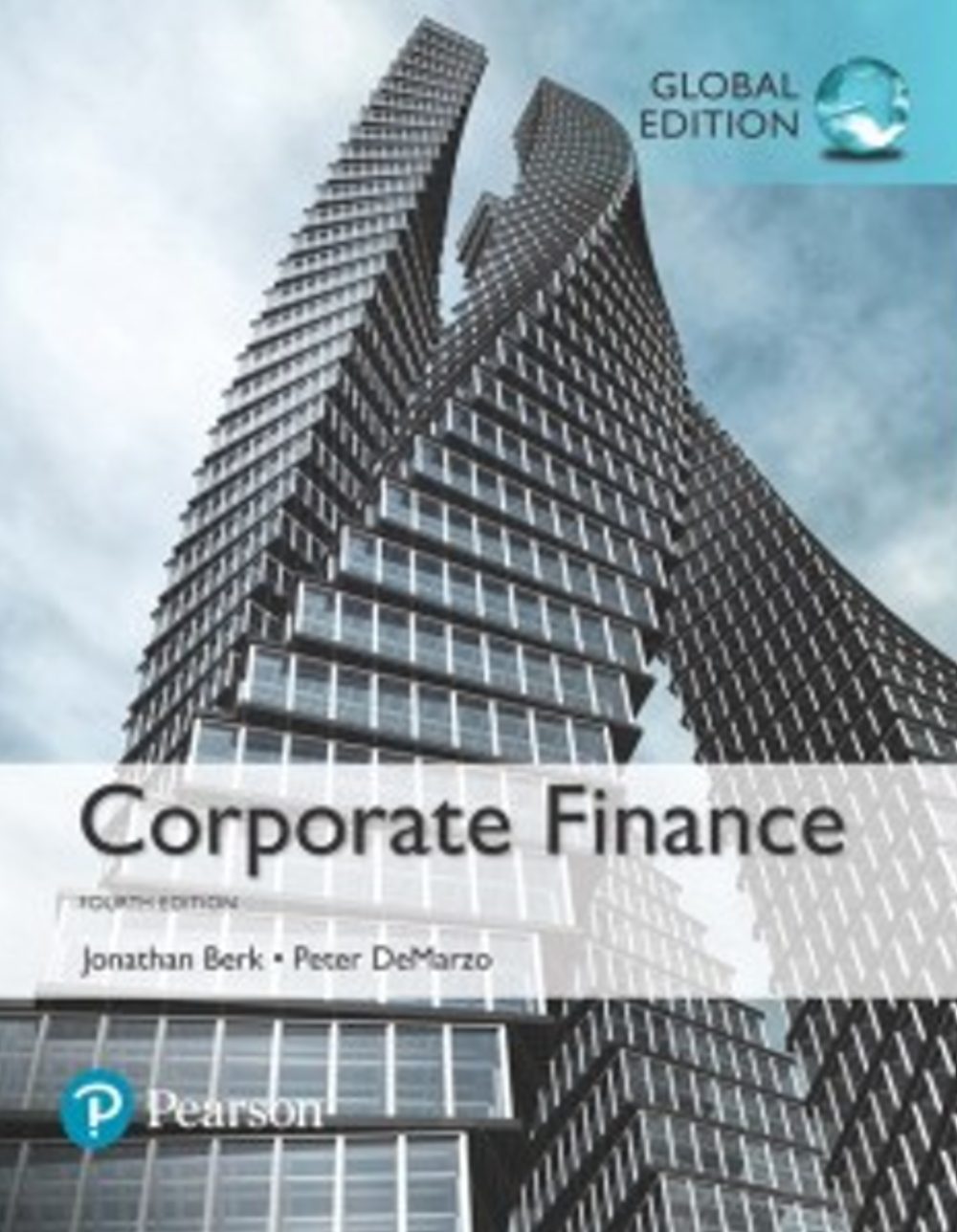|
|
|
Corporate Finance, Global Edition(第四版)
|

|

沒有庫存
訂購需時10-14天
|
|
|
|

|
|
9781292160160 | |
|

|
|
Jonathan Berk | |
|

|
|
新陸書局 | |
|

|
|
2016年12月21日
| |
|

|
|
453.00 元
| |
|

|
|
HK$ 407.7
|
|
|
|
|

| |
|
|
|
|
| |
|
|
詳
細
資
料
|
ISBN:9781292160160規格:平裝 / 1152頁 / 普通級 / 單色印刷 / 四版出版地:美國
|
|
分
類
|
專業/教科書/政府出版品 > 財經類 > 財務金融 > 財務管理 |
同
類
書
推
薦
|
|
|
內
容
簡
介
|
Description
For MBA/graduate students taking a course in corporate finance.
An Emphasis on Core Financial Principles to Elevate Individuals’ Financial Decision Making
Using the unifying valuation framework based on the Law of One Price, top researchers Jonathan Berk and Peter DeMarzo have set the new canon for corporate finance textbooks. Corporate Finance, Fourth Edition blends coverage of time-tested principles and the latest advancements with the practical perspective of the financial manager, so students have the knowledge and tools they need to make sound financial decisions in their careers.
For a streamlined book specifically tailored to the topics covered in the first one-semester course, Corporate Finance: The Core is also available by Jonathan Berk and Peter DeMarzo.
MyFinanceLabTM not included. Students, if MyFinanceLab is recommended/mandatory component of the course, please ask your instructor for the correct ISBN and course ID. MyFinanceLab should only be purchased when required by an instructor. Instructors, contact your Pearson representative for more information.
MyFinanceLab is an online homework, tutorial, and assessment product designed to personalize learning and improve results. With a wide range of interactive, engaging, and assignable activities, students are encouraged to actively learn and retain tough course concepts.
New To This Edition
Coverage of The Latest Developments in the Field
•UPDATED! Focus on the 2007–2009 Financial Crisis and Sovereign Debt Crisis. Twenty-two Global Financial Crisis boxes reflect the reality of the recent financial crisis and ongoing sovereign debt crisis, noting lessons learned. Boxes across the book illustrate and analyze key details.
•Applications that Reflect Real Practice. Corporate Finance features actual companies and leaders in the field:
oSix interviews with notable practitioners highlight leaders in the field and address the effects of the financial crisis and ongoing European sovereign debt crisis.
•Nobel Prize boxes reflect recent Nobel prizes awarded for material covered in the book.
Specific Content Changes
•Material that addresses the implications of negative interest rates has been added throughout the book.
•Coverage describes the ongoing changes to how stocks are traded worldwide. Also, the Dodd-Frank Act information has been updated and a new interview with M. Hathaway, NASDAQ has been included (Chapter 1).
•Interview with Ruth Porat, Google and an expanded explanation of key financial ratios have been added (Chapter 2).
•Box on the dynamics of stock index arbitrage and high frequency trading has been added (Chapter 3).
•Box on annuity due has been included (Chapter 4).
•Data Caseon Florida’s pension plan liability has been added (Chapter 5).
•Expanded coverage of the European debt crisis, including a case study on the Greek default, has been added (Chapter 6).
•Common Mistake box on the sunk cost fallacy has been included (Chapter 8).
•Extensive data updates throughout have been made to reflect current market conditions (Chapter 10).
•Common Mistake box on using a single cost of capital in multidivisional firms and a new Using Excel box on estimating beta have been added (Chapter 12).
•UPDATED! Coverage of recent developments in asset pricing, discussion of fund manager performance, and an interview with Jonathan Clements, former columnist at WSJ, have been updated or expanded (Chapter 13).
•Materialthat relates the capital structure to the current debate on bank leverage has been added throughout Part 5.
•Box on the repatriation tax controversy has been included (Chapter 15).
•UPDATED! Discussion of corporate cash retention has been added (Chapter 17).
•Interview with Zane Rowe, VMWare, and material explaining the relation between DCF and residual income valuation methods, have been added (Chapter 18).
•Using Excel box “Summarizing Model Outputs” has been added (Chapter 19).
•Redesigned sections of Chapter 22, including new examples of decision tree methodology, make the exposition clearer.
•Increased coverage of early stage financing, including a detailed explanation of angel financing and venture capital deal terms; an expanded explanation of typical returns investors make; a new Common Mistake box on misinterpreting startup valuations; and a new interview with Kevin Laws, AngelList, have all been added (Chapter 23).
•Box on Detroit’s municipal bond default has been included (Chapter 24).
•UPDATED!New FASB rules for lease accounting and a new interview with Mark S. Long, XOJet have been added (Chapter 25).
•Boxon the Ex-Im Bank controversy has been included (Chapter 27).
•Expanded discussion of valuation and premiums paid has been added (Chapter 28).
•Discussion of shareholder activism and its recent impact on corporate governance is now included (Chapter 29).
MyFinanceLabTM not included. Students, if MyFinanceLab is a recommended/mandatory component of the course, please ask your instructor for the correct ISBN and course ID. MyFinanceLab should only be purchased when required by an instructor. Instructors, contact your Pearson representative for more information.
•Auto-Graded Excel Projects use proven, field-tested technology, allowing instructors to seamlessly integrate Excel problems into their course.
•UPDATED! HTML5 Player. In addition to matching the Flash player’s support of Accessibility requirements, the HTML5 player has a new “Show Work” feature to allow students to enter text either from a keyboard or stylus and to draw freehand on different backgrounds, such as a coordinate graph, with multiple fonts and colors. Students can also continue to upload images such as phone photos of handwritten work. Printing enhancements include:
oa more pen-and-paper-friendly layout of exercises
othe ability for instructors to choose whether to print the header; to include an honor statement; and to print with answers in line, after each question, or on a separate sheet
|
|
目
錄
|
PART 1: INTRODUCTION
1. The Corporation
2. Introduction to Financial Statement Analysis
3. Financial Decision Making and the Law of One Price
PART 2: TIME, MONEY, AND INTEREST RATES
4. The Time Value of Money
5. Interest Rates
6. Valuing Bonds
PART 3: VALUING PROJECTS AND FIRMS
7. Investment Decision Rules
8. Fundamentals of Capital Budgeting
9. Valuing Stocks
PART 4: RISK AND RETURN
10. Capital Markets and the Pricing of Risk
11. Optimal Portfolio Choice and the Capital Asset Pricing Model
12. Estimating the Cost of Capital
13. Investor Behavior and Capital Market Efficiency
PART 5: CAPITAL STRUCTURE
14. Capital Structure in a Perfect Market
15. Debt and Taxes
16. Financial Distress, Managerial Incentives, and Information
17. Payout Policy
PART 6: ADVANCED VALUATION
18. Capital Budgeting and Valuation with Leverage
19. Valuation and Financial Modeling: A Case Study
PART 7: OPTIONS
20. Financial Options
21. Option Valuation
22. Real Options
PART 8: LONG-TERM FINANCING
23. Raising Equity Capital
24. Debt Financing
25. Leasing
PART 9: SHORT-TERM FINANCING
26. Working Capital Management
27. Short-Term Financial Planning
PART 10: SPECIAL TOPICS
28. Mergers and Acquisitions
29. Corporate Governance
30. Risk Management
31. International Corporate Finance
|
|
|
書
評
|
|
|
|

